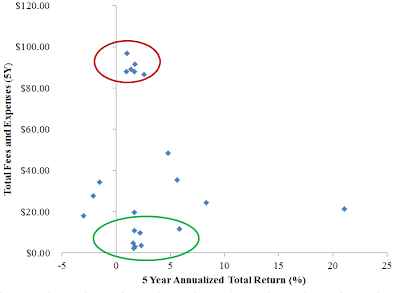Leveraged Exposure to the Mortgage REIT Sector
(Oct 2012)
Michael Aneiro over at Barron's pointed out an interesting recent SEC 424(b)2 filing from ETRACS for their Monthly Pay 2x Leveraged Mortgage REIT ETN (MORL). According to the prospectus, the ETNs will "provide a monthly compounded two times leveraged long exposure to the performance of the [Market Vectors Global Mortgage REITs Index], reduced by the Accrued Fees." This ETN is essentially a leveraged version of Market Vectors Mortgage REIT ETF (MORT) which tracks the same underlying index.
...
Mutual Funds Holding Leveraged and Inverse Leveraged ETFs
(Oct 2012)
While looking through recent SEC filings, an updated prospectus happened to catch our eye. The prospectus offers updated information concerning the investment strategy and details of two mutual funds: USFS Funds Limited Duration Government Fund (USLDX) and USFS Funds Tactical Asset Allocation Fund (USFSX).
The fund management company -- Pennant Management, Inc. -- states in this prospectus that "[USFSX] may invest up to 33% of its assets in leveraged ETFs and inverse ETFs, up to 10% of its...
Holding an ETF During the Day vs. Holding Overnight
(Oct 2012)
Lately we've been reading the interesting new book by Eric Falkenstein on risk premia and low volatility investing. We are long time followers of Eric's blog, which has a variety of interesting analyses of equity markets.
Following one of the figures in his book, we decided to look at two different strategies of investing in a given ETF where the holding period is on average one trading day. In particular, we looked at the pricing data of SPDR S&P 500 (SPY) since inception and constructed two...
ETFs are Finding Their Way into 401(k) Plans
(Aug 2012)
In a recent blog post we discussed how mutual fund fees can drastically reduce funds available for retirement (see "401(k) Fees Can Drastically Reduce Nest Egg"). We cited a paper from the Center for Retirement Research that studied a typical 401(k) plan's investment costs, which including advertising fees, administration fees, asset management fees, and trading costs total 1-2% of assets annually. The paper proposed boosting the returns of 401(k) plans by investing in passively managed and...
401(k) Fees Can Drastically Reduce Nest Egg
(Jun 2012)
A recent report conducted by Demos -- a New York City-based public policy organization -- points out that the high fees charged by 401(k)'s can cut nest eggs by 30% for median-income two-wage family.
Company-sponsored 401(k) plans often include a list of mutual funds in which employees can invest. Although these fees are disclosed on the individual fund prospectuses, the account statements from 401(k)'s generally do not include such fees (only the result of the fund performance net of fees)....
Is There No Tracking Error for ETNs?
(Apr 2012)
Some investors may think that while ETFs are subject to various tracking errors, ETNs are not. The argument goes that index-tracking ETFs often hold part or the entire portfolio underlying their targeted index and are thus subject to imperfect tracking and transaction costs. ETNs, on the other hand, are debt instruments, and have returns guaranteed by their issuers.
It turns out, however, that the daily return of an ETN investment may not necessarily equal the leverage ratio times the daily...
A Primer on Investment Companies
(Mar 2012)
Investment companies are entities that issue securities and whose primary business is investing in securities. We have written about investment companies in several of our posts (See blog posts on ETFS and Mutual Funds). This post provides a quick introduction to investment companies and the securities they issue. The three main types of investment companies according to federal securities regulation are: closed-end funds, unit investment trusts, and open-end funds.
Some of the main...
Which Would You Rather Have?
(Mar 2012)
Last month we had a blog post introducing the FINRA Mutual Fund Expense Analyzer tool. In this post we apply it to the 25 largest mutual funds and ETFs measuredby net asset value using data from Morningstar. We assumed for this calculation an initial investment of $1,000 held for five years, and plot the total fees and sales charges over that period against the historical 5 year annualized total return of the fund:
There is no clear linear relationship between returns and fees as depicted in...

